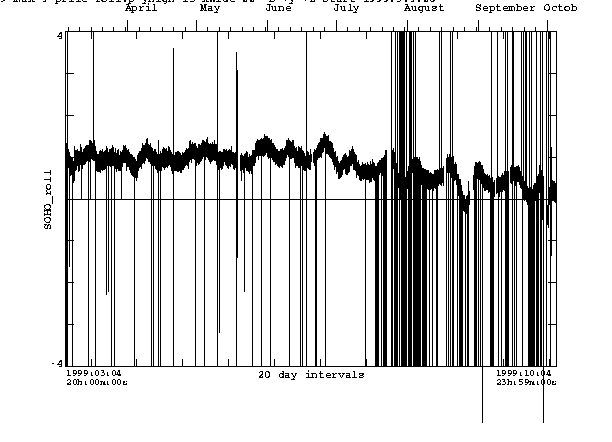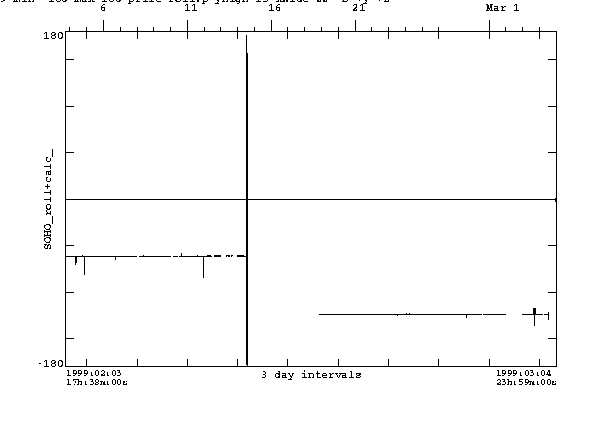SOHO Roll Determination From MDI loi_V Data
Method to Estimate SOHO Roll
MDI Doppler shift velocity observations can be used to deduce the position angle of the Sun in the MDI instrument. Since the nominal roll angle of SOHO is such that the top of the MDI CCD image is solar North, any deviation from that roll will be apparent as a position angle error in MDI data.
The largest Doppler signal from the Sun is simply solar rotation. If the Sun's image is rotated there will appear to be some component of solar rotation in the MDI up-down direction. So to estimate the roll angle we can simply look for the erroneous North-South component of rotation. To do this we average the disk velocity into the north half, south half, east half, and west half. Then the roll error is estimated as arctangent((Vnorth - Vsouth) / (Vwest - Veast)).
There are some corrections that must be included. Since the spacecraft, and the Earth, are moving about 30km/s around the sun in the ecliptic and the Sun is tilted to the ecliptic by about 7.25 degrees, there is a component of the orbit velocity in the north-south direction. This correction varies through the year by +- 0.5 degrees.
For SOHO operations we want to know the roll of the spacecraft compared to the ecliptic pole. Since we observe the Sun's position angle by finding the direction of the Sun's pole, the projection of the Sun's pole on the ecliptic pole as viewed from SOHO must be included. Here is a plot of this angle. (This is the correction that should be added to 297.12 degrees to find the Sun's pole in Feb 1999) This correction is nearly an annual term varying as the cos(day-Dec7) with amplitude 7.25 degrees. Since the Earth does not move at a uniform rate through the year there is a small correction term that is up to 0.3 degrees that needs to be added if the p angle is approximated with a simple cosine of phase in year estimate. Since the quick analysis of the MDI data does not have the correct ecliptic longitude of the spacecraft available the correction to a uniformly moving SOHO is used and a correction is added. The correction is in this plot. The error in assuming SOHO is at the Earth amounts to about 0.02 degrees at the most for these corrections.
Historical Estimate of SOHO Roll
The pangle error has been computed in this way for the first two years of the mission. This plot shows data from May 1996 through June 1998. It can be seen that there are jumps of about 0.5 degree that coincide with MDI Doppler tuning changes. These are due to errors in the MDI Doppler calibration (that do not affect oscillation studies!) We are investigating the source of these jumps, and the associated long term trends. The data below has been averaged into 1 hour bins after removing isolated erroneous values and the command roll interval. The planned roll in March 1997 is shown with larger limits here.
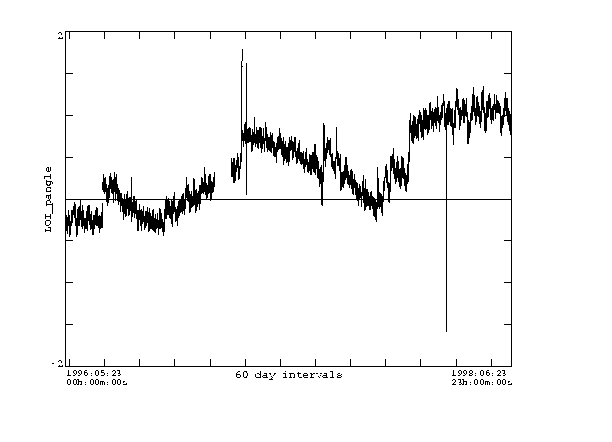
Current Estimate of SOHO Roll
The current estimate of the SOHO roll angle is below. It is apparently about a degree off from the SOHO actual roll which is very near 0 degrees when the roll steering law is being followed. This analysis includes all available data but the plot is clipped to show only the region near zero to highlight the variations. The data is also available as an ascii table THIS TABLE AND PLOT IS THE APPARENT ROLL COMPARED TO TRUE SOLAR NORTH. This plot is updated daily.
By comparison the SOHO Definitive Attitude files, e.g. /soho-archive/public/data/ancillary/AT_FTR/SO_AT_FTR_19990323_V01.TXT, shows:
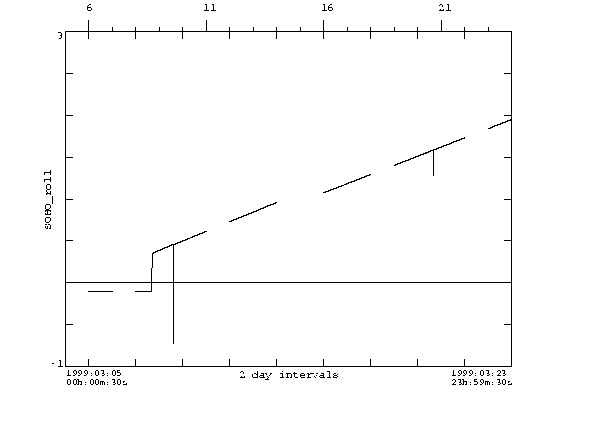
These files claim to be "roll angle offsets from the projection of the Sun's North Pole" but are evidently in ecliptic coordinates. The data here is averaged into minutes. The correction for projection of the Sun on the ecliptic should be added to this plot to show the attitude file estimate of the roll. The following plot shows this quantity in red and the calculated projection of the solar pole on the ecliptic in blue.
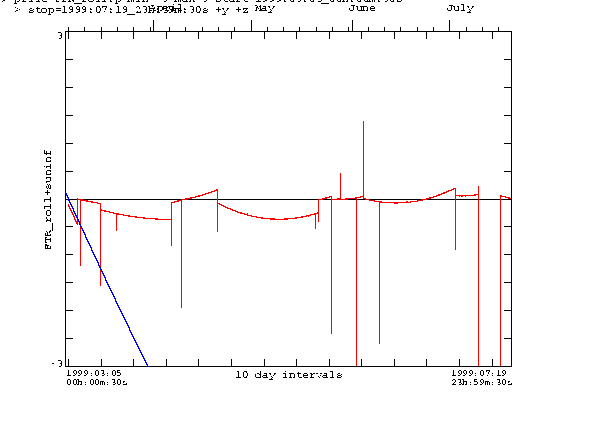
SOHO attitude files and LOI_V data are compared in the next 3 plots. The first is for normal times during the first 2 years of MDI observations. The S/C data has been shifted down 1 degree to prevent confusion.

In the second plot, the March 1997 roll is shown with both MDI and attitude data shown. The wrap at 180 degrees differs due probably to noise and sampling.

In the third, recent data is shown with the MDI data shifted down 1 degree and in red. SOHO data in blue. The offset in early March is clear. The later offsets are less clear - or seemingly absent.
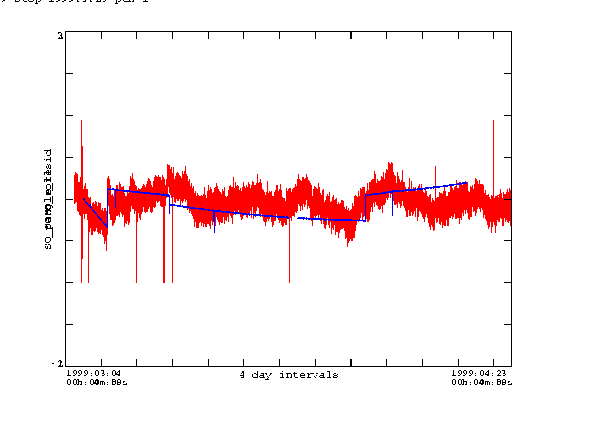
In addition to the long term trends there are four types of shorter term variations that can be seen in this data.
- Large jumps: These are due to erroneous data. Can be due to cosmic ray hits in memory, telemetry loss, etc. They are simply discarded in the plots below.
- Minute-to-minute variations: The solar p-mode oscillations are easily detected in the apparent roll angle. It is simply the low-degree p-modes leaving a residual North-South velocity component. This can be clearly seen in a blowup of the last six hours from Feb 3. The most recent two full days are shown below.

- Several hour variations: These are likely residuals from the rotation of supergranules. They can be seen here in 30-minute averages of the data.
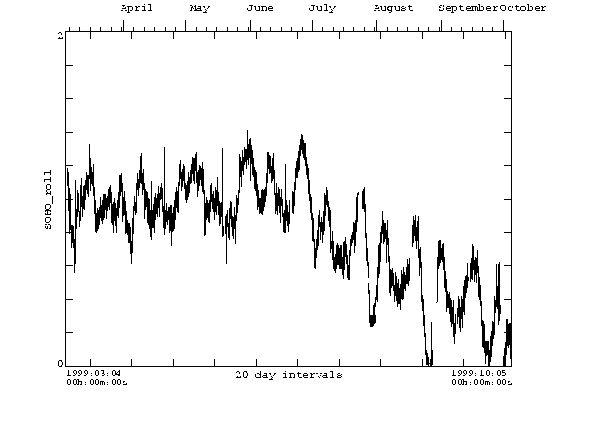
- Several day long variations: These at least in part due to the rotation of solar active regions. They can be seen in the last few months in 1998 prior to the SOHO interruption in the plot above. A closeup of March and April 1998 from the 2-year plot above shows the typical sudden drop as an active region rotates onto the disk followed by a 12-14 day rise as it rotates across the disk. This data is 1 hour averages of the apparent P angle error from the nominal solar north direction.
The raw absolute roll angle can apparently be determined from the raw loi_V data to within about 1.5 to 2 degrees prior to any correction. If an offset averaged over several days is maintained and used as a correction, the absolute roll should be able to be determined to within less than 0.5 degrees from a one hour average, or about a degree from a 5-minute average. Individual values should not be used in isolation since one minute spikes can be large.
Estimate of SOHO Roll in the Feb 1999 Interval
The roll angle during the 2 Feb through 4 March offset roll interval is shown below. It is apparently about a degree off from the SOHO actual roll angle which is about -62.9 degrees in early February. This offset is probably related to MDI calibration issues and will be very slowly changing on a weekly time scale. The offset was closer to 3 degrees after the s/c rolled to -120 in the 14-18 Feb roll. The data is also available as an ascii table THIS TABLE AND PLOT IS THE APPARENT ROLL COMPARED TO THE ECLIPTIC.
Feb 14 SOHO ESR MDI Roll Measurements
This is a plot of the loi_V estimated roll during the 12 UT to 14 UT interval of 14 Feb when SOHO experienced a loss of roll stability. The plot shows a full 360 degree range. This data will be examined along with pointing information to study the effect of off-pointing on the roll knowledge using this simple algorithm.
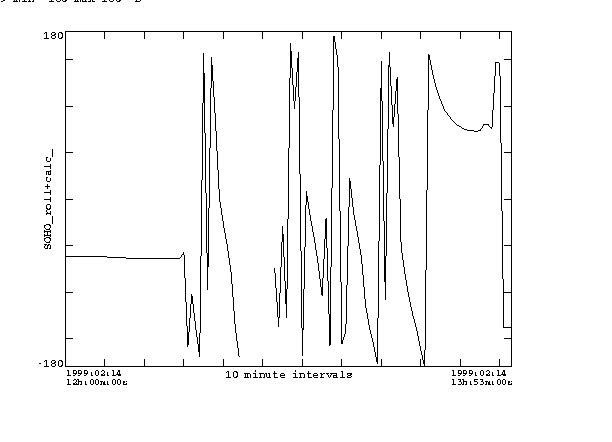
These plots show the loi_Ic determined pointing as e.g. (N-S)/(N+S) intensity. So they show the fractional intensity error. The avergae intensity is also shown. When it varies much from the trend the intensity and roll information is probably useless. When the average intensity is negative, the data is clearly useless - it can be due to rapid motion during a 1-minute velocity/intensity observation.
(north - south)/average

(east - west)/average
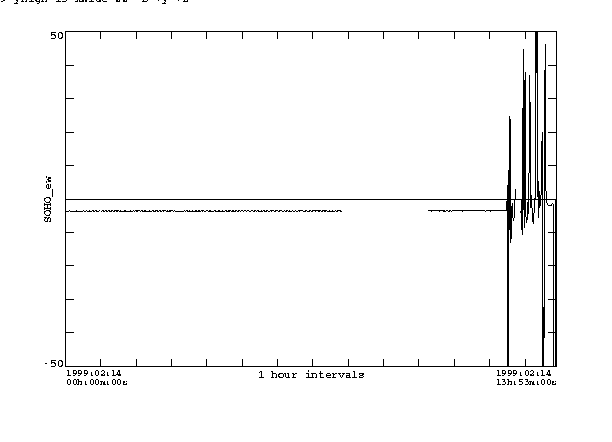
average
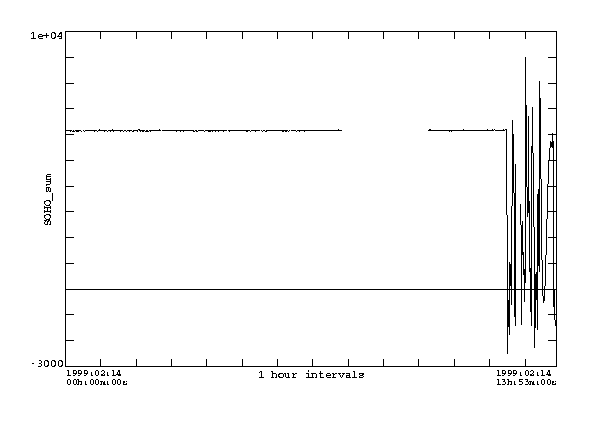
This page is http://quake.stanford.edu/~phil/roll.html
Last Updated: 11 Feb 1999
